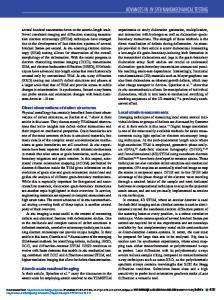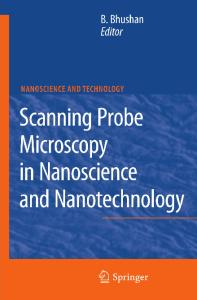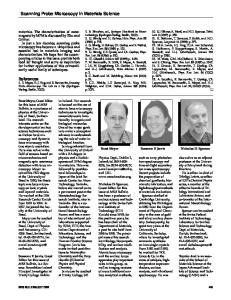In Situ Scanning Probe Microscopy Nanomechanical Testing
- PDF / 764,058 Bytes
- 7 Pages / 612 x 792 pts (letter) Page_size
- 98 Downloads / 401 Views
Probe Microscopy Nanomechanical Testing Xiaodong Li, Ioannis Chasiotis, and Takayuki Kitamura
Abstract Scanning probe microscopy (SPM) has undergone rapid advancements since its invention almost three decades ago. Applications have been extended from topographical imaging to the measurement of magnetic fields, frictional forces, electric potentials, capacitance, current flow, piezoelectric response and temperature (to name a few) of inorganic and organic materials, as well as biological entities. Here, we limit our focus to mechanical characterization by taking advantage of the unique imaging and force/displacement sensing capabilities of SPM. This article presents state-of-theart in situ SPM nanomechanical testing methods spanning (1) probing the mechanical properties of individual one-dimensional nanostructures; (2) mapping local, nanoscale strain fields, fracture, and wear damage of nanostructured heterogeneous materials; and (3) measuring the interfacial strength of nanostructures. The article highlights several novel SPM nanomechanical testing methods, which are expected to lead to further advancements in nanoscale mechanical testing and instrumentation toward the exploration and fundamental understanding of mechanical property size effects in nanomaterials.
Introduction Recent developments in science and engineering have provided the capability to fabricate and control structures and materials at the nanoscale. The functionality and reliability of micro/nanodevices are often determined by the mechanical properties of the individual nanostructures and the different materials comprising these devices. In this regard, it has been shown that the mechanical properties of structures and materials are size-dependent. Since nanostructures and nanostructured materials often exhibit unique properties at ultrasmall scales, unlike their counterparts at the macroscale, the successful transition of nanostructures and nanostructured materials to practical applications requires their mechanical characterization at the nanoscale.1–7 To perform such nanoscale mechanical experiments, an instrument needs to have two basic functions: to “see”
a nanostructure and deform/fracture the nanostructure in situ. Scanning probe microscopy (SPM) detects interactions between a nanoscale probe and a nearby surface in order to map the surface morphology and its properties.8,9 By taking advantage of SPM’s high spatial resolution, a micro/nanomechanical tester can be integrated with an SPM to perform mechanical experiments on nanostructured bulk materials where the sample surface is imaged in situ by the SPM. Possessing both nanoscale force and displacement sensing capabilities, atomic force microscopy (AFM) and its variants are also able to directly probe the mechanical properties of nanostructures and nanostructured bulk materials. As will be demonstrated in the following selected examples, SPM provides insights into the mechanical behavior of nanostructures and nanostructured bulk
MRS BULLETIN • VOLUME 35 • MAY 2010 • www.mrs.org/bulleti
Data Loading...











